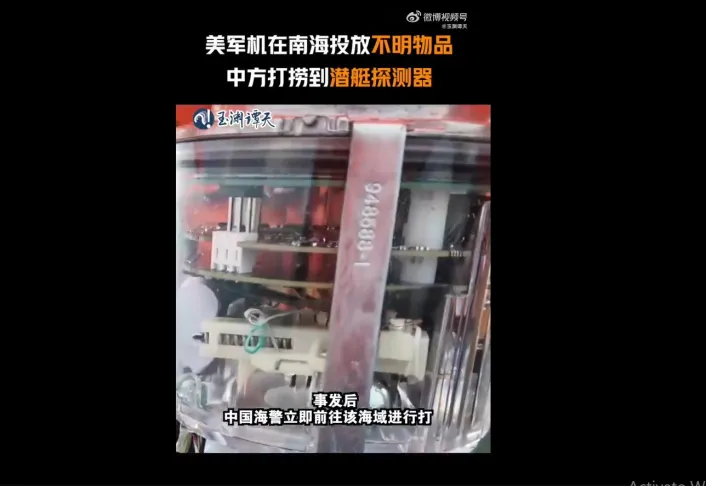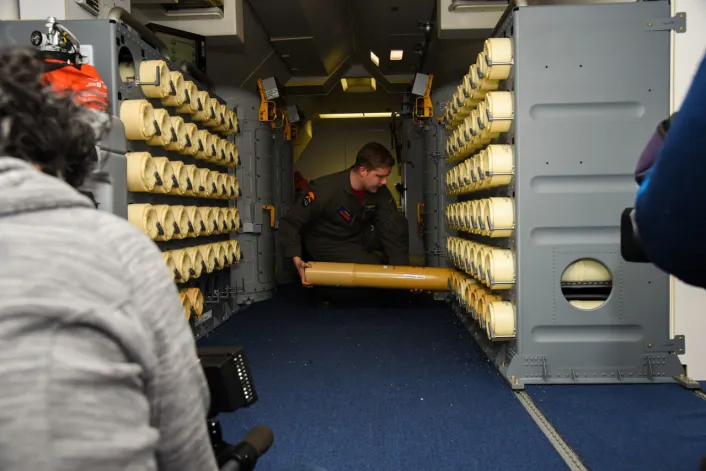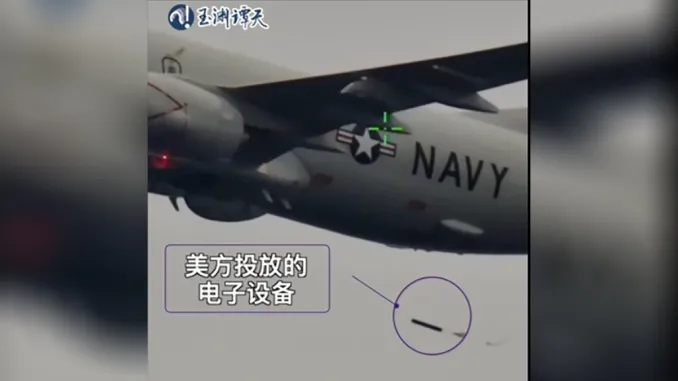Chinese media said the recovered device was being used to detect Chinese submarines’ signals and counter them.
A video recently appeared on Chinese social media shows China Coast Guard personnel recovering what appears to be a sonobuoy dropped from a U.S. Navy P-8A Poseidon MPA (Maritime Patrol Aircraft) aircraft in the SCS (South China Sea). The incident seems to have taken place over the last two to three days.
The heavily stylized video, with text and background music infusions, shows a P-8 Poseidon, tracked by an electro-optical sensor, flying at low altitude and releasing the sonobuoy, with Chinese personnel showing its internal components after retrieving it.
A close-up view of the sonobuoy’s internal electronics circuits showed the components’ maker as Ultra Electronics, with the product manufactured in Jul. 2023, according to the tag. The makers of the video also traced the company’s official public material and product information, which advertised them as leading undersea warfare technology providers.
Video from China’s Yuyuan Tantian, showing Chinese capturing a sonar “submarine detector” dropped from a US Navy P-8A Poseidon aircraft. pic.twitter.com/Tjvl2aen1y
— Parth Satam (@ParthSatam) June 28, 2024
‘Submarine, sonar detectors are threats’
China has captured US sonobuoys and probes before, with a famous incident in December 2016, when one of its naval vessels took hold of an UUV (Unmanned Underwater Vessel) just as it was being retrieved by the oceanographic survey vessel USNS Bowditch. The Pentagon said at the time that they “secured an understanding through direct engagement with the Chinese authorities (to) return the UUV to the United States.”
Reuters identified the social media channel on Weibo that created the video as Yuyuan Tantian, associated with Chinese state broadcaster CCTV (China Central Television). In the video, the sonobuoy is released with a drag parachute to slow its fall, which was “salvaged by the China Coast Guard.”
According to Global Times, the CCG “observed a US military aircraft circling above SCS waters and repeatedly dropping unidentified items during a recent patrol. CCG subsequently retrieved and inspected these unidentified electronic items.” Calling it a “submarine detector,” Global Times said it was dropped near the Ren’ai Jiao/Ren’ai Reef, also dubbed the Second Thomas Shoal.

The southern part of the SCS off the Philippine province of Palawan, is also the scene of constant clashes between the Chinese and Philippine coast guards since 2023. Manila’s boats running supplies to the abandoned Sierra Madre ship, functioning as its outpost, are stopped by Chinese vessels by either ramming or firing water cannons towards them.
Global Times quoted an unidentified expert who said that Ultra Electronics provides “comprehensive services to the US Navy.” The expert continued mentioning that the device is capable of “detecting signals from Chinese submarines and engaging in signal countermeasures underwater.” CGTN further added that “noise from the device’s sonar can also interfere with the echolocation systems of marine creatures like dolphins, disorienting them and even stranding them.”
“Aiming to gather more hydrological data, the U.S. intends to develop digital ocean maps for military purposes and analyze information related to Chinese submarines, posing a serious threat to China’s national and military security,” the expert added. “No matter how many are deployed, we will identify and seize them all, and implement necessary countermeasures.”
What would China do with the sonar devices?
Although it’s a one-time device, the sonobuoy will certainly be studied by Chinese engineers.
If the electronic circuits are not damaged, Chinese engineers will likely examine its detection capabilities to identify the range and frequencies it is most effective and might try to reverse engineer the system and gain an insight into Western sonar technology. This could possibly lead to similar systems being integrated on Chinese MPA aircraft or countermeasures specifically tailored to block the transmission of the “enemy” sonobuoys.
That being said, it’s worth highlighting that sonobuoys are used to collect data and transmit it: it’s not on that device that the processing takes place. Therefore, the fact that China has recovered one is probably not a big deal despite the hype on social networks.

Sonobuoy developer and variant
Ultra Electronics, headquartered in London, bases its sonobuoys business at Fort Wayne in Indiana. An earlier report on Sea Power Magazine mentioned that NAVAIR (Naval Air Systems Command) had awarded ERAPSCO a $1 billion contract to manufacture and deliver a maximum of 37,500 SSQ-36B sonobuoys, 685,000 SSQ-53Gs, 120,000 SSQ-62Fs and 90,000 SSQ-101Bs for fiscal years 2019 through 2023. It is not clear what variant the sonobuoy captured by the Chinese belongs to.
Another April 2022 report quoted Eric Webster, Ultra’s president for Sonobuoy Systems during the Sea-Air Space 2022 exhibition, revealing that ERAPSCO is his company’s joint venture with Israel’s Elbit, and is producing 200,000 sonobuoys annually. The “level is approaching the number built annually during the mid-1980s in the midst of the Cold War, when U.S. Navy and allied ASW expended thousands of sonobuoys to track Soviet submarines.”









